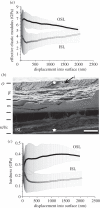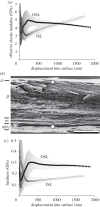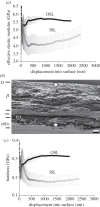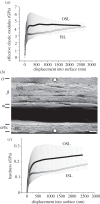Epidermis architecture and material properties of the skin of four snake species
- PMID: 22896567
- PMCID: PMC3479930
- DOI: 10.1098/rsif.2012.0479
Epidermis architecture and material properties of the skin of four snake species
Abstract
On the basis of structural and experimental data, it was previously demonstrated that the snake integument consists of a hard, robust, inflexible outer surface (Oberhäutchen and β-layer) and softer, flexible inner layers (α-layers). It is not clear whether this phenomenon is a general adaptation of snakes to limbless locomotion or only to specific conditions, such as habitat and locomotion. The aim of the present study was to compare the structure and material properties of the outer scale layers (OSLs) and inner scale layers (ISLs) of the exuvium epidermis in four snake species specialized to live in different habitats: Lampropeltis getula californiae (terrestrial), Epicrates cenchria cenchria (generalist), Morelia viridis (arboreal) and Gongylophis colubrinus (sand-burrowing). Scanning electron microscopy (SEM) of skin cross sections revealed a strong variation in the epidermis structure between species. The nanoindentation experiments clearly demonstrated a gradient of material properties along the epidermis in the integument of all the species studied. The presence of such a gradient is a possible adaptation to locomotion and wear minimization on natural substrates. In general, the difference in both the effective elastic modulus and hardness of the OSL and ISL between species was not large compared with the difference in epidermis thickness and architecture.
Figures







Similar articles
-
Ultrastructure and wear patterns of the ventral epidermis of four snake species (Squamata, Serpentes).Zoology (Jena). 2014 Oct;117(5):295-314. doi: 10.1016/j.zool.2014.01.004. Epub 2014 Jun 24. Zoology (Jena). 2014. PMID: 25169958
-
Scratch resistance of the ventral skin surface in four snake species (Squamata, Serpentes).Zoology (Jena). 2016 Apr;119(2):81-96. doi: 10.1016/j.zool.2015.12.006. Epub 2016 Jan 3. Zoology (Jena). 2016. PMID: 26874374
-
Material properties of the skin of the Kenyan sand boa Gongylophis colubrinus (Squamata, Boidae).J Comp Physiol A Neuroethol Sens Neural Behav Physiol. 2010 Sep;196(9):659-68. doi: 10.1007/s00359-010-0556-y. Epub 2010 Jul 10. J Comp Physiol A Neuroethol Sens Neural Behav Physiol. 2010. PMID: 20623229
-
Functional diversity of snake locomotor behaviors: A review of the biological literature for bioinspiration.Ann N Y Acad Sci. 2024 Mar;1533(1):16-37. doi: 10.1111/nyas.15109. Epub 2024 Feb 17. Ann N Y Acad Sci. 2024. PMID: 38367220 Review.
-
Facultatively Sidewinding Snakes and the Origins of Locomotor Specialization.Integr Comp Biol. 2020 Jul 1;60(1):202-214. doi: 10.1093/icb/icaa011. Integr Comp Biol. 2020. PMID: 32176289 Review.
Cited by
-
Friction anisotropy with respect to topographic orientation.Sci Rep. 2012;2:988. doi: 10.1038/srep00988. Epub 2012 Dec 17. Sci Rep. 2012. PMID: 23248751 Free PMC article.
-
Friction behavior of a microstructured polymer surface inspired by snake skin.Beilstein J Nanotechnol. 2014 Jan 24;5:83-97. doi: 10.3762/bjnano.5.8. eCollection 2014. Beilstein J Nanotechnol. 2014. PMID: 24611129 Free PMC article.
-
In slow motion: radula motion pattern and forces exerted to the substrate in the land snail Cornu aspersum (Mollusca, Gastropoda) during feeding.R Soc Open Sci. 2019 Jul 3;6(7):190222. doi: 10.1098/rsos.190222. eCollection 2019 Jul. R Soc Open Sci. 2019. PMID: 31417728 Free PMC article.
-
Bio-Inspired Functional Surfaces Based on Laser-Induced Periodic Surface Structures.Materials (Basel). 2016 Jun 15;9(6):476. doi: 10.3390/ma9060476. Materials (Basel). 2016. PMID: 28773596 Free PMC article. Review.
-
Harnessing the Wide-range Strain Sensitivity of Bilayered PEDOT:PSS Films for Wearable Health Monitoring.Matter. 2021 Sep 1;4(9):2886-2901. doi: 10.1016/j.matt.2021.06.034. Epub 2021 Jul 15. Matter. 2021. PMID: 34746749 Free PMC article.
References
-
- Klein M.-C., Deuschle J., Gorb S. 2010. Material properties of the skin of the Kenyan sand boa Gongylophis colubrinus (Squamata, Boidae). J. Comp. Physiol. A 196, 659–668 10.1007/s00359-010-0556-y (doi:10.1007/s00359-010-0556-y) - DOI - DOI - PubMed
-
- Mattison C. 1995. The encyclopedia of snakes. London, UK: Cassel & Co
-
- Baden H. P., Maderson P. F. A. 1970. Morphological and biophysical identification of fibrous proteins in the amniote epidermis. J. Exp. Zool. 174, 225–232 10.1002/jez.1401740211 (doi:10.1002/jez.1401740211) - DOI - DOI - PubMed
-
- Landmann L. 1979. Keratin formation and barrier mechanisms in the epidermis of Natrix natrix (Reptilia: Serpentes): an ultrastructural study. J. Morphol. 162, 93–126 10.1002/jmor.1051620107 (doi:10.1002/jmor.1051620107) - DOI - DOI - PubMed
-
- Barbakadze N., Enders S., Gorb S., Arzt E. 2006. Local mechanical properties of the head articulation cuticle in the beetle Pachnoda marginata (Coleoptera, Scarabaeidae). J. Exp. Biol. 209, 722–730 10.1242/jeb.02065 (doi:10.1242/jeb.02065) - DOI - DOI - PubMed
Publication types
MeSH terms
LinkOut - more resources
Full Text Sources

